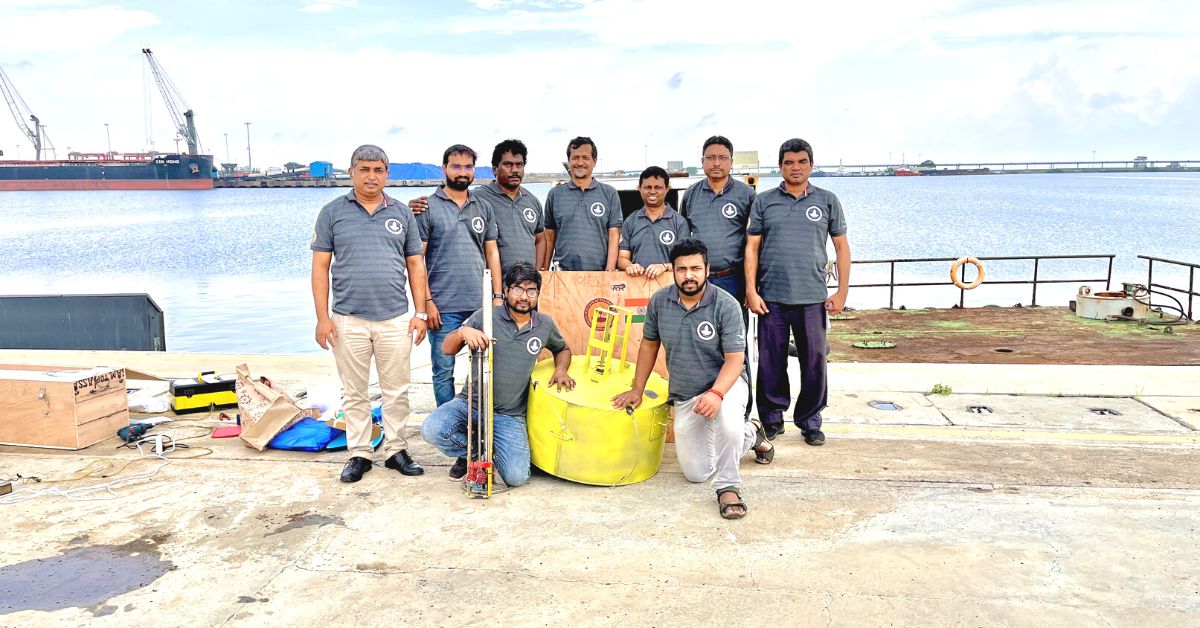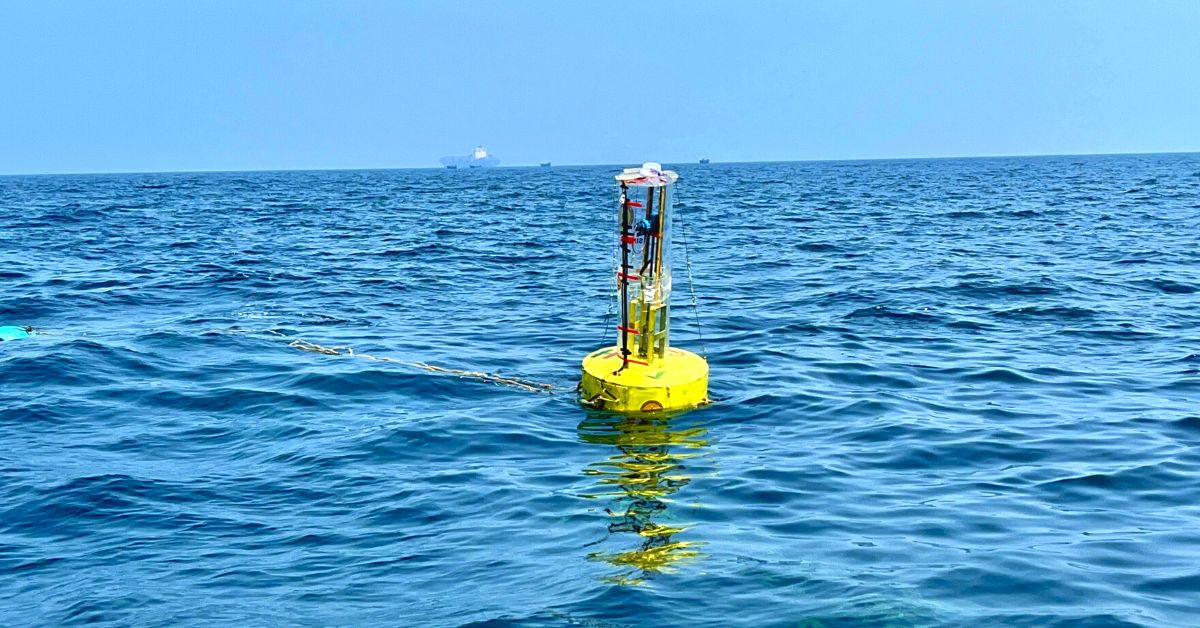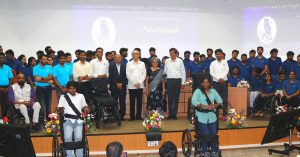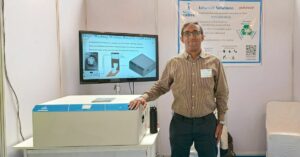IIT-M’s Device Generates Electricity from Sea Waves, Operates 6000m Underwater
Researchers at IIT-Madras built the ‘Ocean Wave Energy Converter’, or the Sindhuja-1, a device to generate electricity from sea waves. The team is led by Professor Abdus Samad, who explains how the device works.

(Above image of The IIT Madras Research Team that developed and deployed the Ocean Wave Energy Converter 6 km off the coast of Tuticorin, Tamil Nadu, in November 2022)
Researchers at IIT-Madras have achieved a real breakthrough in the renewable energy sector, with a way to generate electricity from sea waves. Called the ‘Ocean Wave Energy Converter’, this device was deployed at a remote location 6 km off the coast of Tuticorin, Tamil Nadu, and placed at a depth of 20 metres.
In the second week of November, the team completed trials of this device and now targets generating 1 MW of power from ocean waves in the next three years. The team is led by Professor Abdus Samad, the scientist behind the establishment of the Wave Energy and Fluids Engineering Laboratory (WEFEL) at IIT Madras.
Prof Samad, who has been working on wave energy for over a decade, with his team designed and tested a scaled-down model. Aside from generating electricity, WEFEL is also researching other applications for this breakthrough technology, such as producing power for smaller devices for the ocean like navigational buoys and data buoys, among others.
Speaking to The Better India, Prof Samad says, “The ocean is harsh. There are forces — tidal, waves, wind, tsunamis, cyclones, etc. Sea water is corrosive, and there is an issue of marine algae growth on the machine element. The installation needs special skilled persons like divers. Deploying and maintaining this device in the ocean is also challenging. So, when we design any system, we need to consider all these factors. Finally, the whole task becomes expensive.”
“Also, the wave energy system concept came up about 100 years ago. The idea of generating electricity from sea waves is not new, but the challenges are how you develop the technology and make the system feasible, cost-effective and reliable,” he adds.
This device is targeted towards remote offshore locations that require reliable electricity and communication — either by supplying electric power to payloads integrated directly in or on the device, or located in its vicinity as on the seabed and in the water column. The targeted stakeholders are the oil and gas, defence and security installations, as well as the communication sectors.
IIT Madras and a Visakhapatnam-based startup titled Virya Paramita Energy (VPE) have a joint development agreement to commercialise the technology.
How does the technology work?
The resultant product is called ‘Sindhuja-I,’ which means “generated from the ocean”.
A press release issued by IIT-M states, “The system has a floating buoy, a spar, and an electrical module. The buoy moves up and down as the wave moves up and down. In the present design, a balloon-like system called a buoy has a central hole that allows a long rod called spar to pass through it. The spar can be fixed to the seabed, and passing waves will not affect it, while the buoy will move up and down and produce relative motion between them. The relative motion gives rotation to an electric generator to produce power. In the present design, the spar floats, and a mooring chain keeps the system in place.”
Simply put, here’s how Prof Samad explains it: “Our system has a buoy with a central hole like a doughnut. When waves come, the buoy moves up and down with it. Now a vertical rod passing through the hole touches the sea bottom and does not move with the wave. Hence, we get relative motion between the rod and the doughnut. We put a rack and pinion system so that when the buoy moves up and down, the pinion (wheel) rotates. The wheel transfers power to a generator to produce electricity. I have a few relevant patents on wave energy. The present design will be filed shortly,” he says.
Sindhuja-1 comes from invention and rigorous academic research, notes Prof Samad. Suman Kumar, who completed his Master of Science (M.S.) under Prof Samad, left his lucrative corporate job and joined his team to develop a wave energy system. Besides him, Prof Samad’s team has four PhD scholars working on different aspects of developing the product — study of ocean waves, cost aspects, design and deployment, and numerical analysis.
“We are considering all the known aspects before designing the systems. We feel our system is robust because we tested it in the ocean when the Indian Meteorological Department (IMD) reported a red alert weather prediction, and the system produced power,” he says.

Generating electricity
In India, the National Institute of Ocean Technology (NIOT), Chennai, installed a plant at Vizhinjam (Kerala) to produce electricity using a turbine based system in the 1990s. Later, they designed a ship navigational system with a turbine-based system.
“Globally, a few companies are trying to commercialise different wave energy technologies. We often can not compare the technologies as the ocean is vast, and the application area can be different. Some can be installed near the coast; others away from the coast, etc. We installed our small basic design and observed it produces about 100W peak power,” says Prof Samad.
“We received a DST (Ministry of Science and Technology, Govt of India) project approval of Rs 1 crore. Using that amount, we will produce a more extensive system to reach a few watts to a few kilowatts (kW). We planned to make systems with more than 15 cm diameters producing about 80 kW power. So, an array of 15 systems will produce 1,000 KW or 1 MW of power. We are seeking funds from investors and government agencies for this big plan,” he adds.
Prof Samad says that Sindhuja-1 has some innovative advantages over other existing technologies in this space. “Efficacy-wise, it can be installed anywhere within 10 to 6,000 metres of water depth. It’s not dependent on bathymetry, does not harm sea life, includes no digging of the sea bed and is easily deployable, and portable. This will generate power 24X7 with almost negligible battery storage. It can be an excellent choice for sea surveillance, offshore desalination, coral reef regeneration, offshore communication, drone charging/underwater vehicle charging, weather buoy, navigational buoy, etc.”
How does it compare to other renewables?
Solar and wind are mature technologies, and their cost has significantly reduced since inception. Also, solar and wind need battery storage and are also expensive when running in the ocean. In fact, wind turbines may not be able to handle 6km of water depth.
“On the other hand, wave energy is 24×7, with low battery requirement (less than 10% of the battery requirement of the solar energy system) and we can go to any depth. Also, solar energy can be harvested for a few hours during daytime, so you need a larger battery source. Our system is still in the research and development (R&D) stage.” he says.
The origin story
A couple of years ago, Prof Samad was designing turbines for NIOT for their navigational buoy. Meanwhile, he was also studying wave energy technologies. An important stage in the development of this technology came with the arrival of Vishnu Vijayasankar as an MS student under Prof Samad. Today, he’s doing his PhD at Virginia Tech, USA.
It was Vijay who came up with the idea of designing a 15 cm diameter buoy. Along with a couple of MTech students from the Department of Ocean Engineering, Vijay left for Coimbatore to design and manufacture the Point Absorber Wave Energy Converter, a precursor to the current device. After spending a week, he got the device tested, graduated and left for the US.
Following Vijay, another MS student under Prof Samad, Sumar Kumar, conducted multiple tests, performed analyses and after graduating found work in the corporate sector. However, Suman soon left his job and returned to continue working on developing the wave energy converter. Similarly, other research students also joined Prof Samad in this endeavour.
As he says, “I set off alone towards my goal, but people came along and it began to turn into a caravan.”
“We started designing this device when Vishnu was a student at IIT Madras. Then once Suman rejoined us, the lockdown started. Our original design got disposed of, but Sai Karthik Sunkara, the CEO of VPE, approached us in mid-2020 and explored the possibilities of bringing it into reality, following which we started working on it together. In 2022, when students again came back to IIT-M, we received funds from the Australian and Indian governments to develop the device jointly with team VPE. Finally, real ocean testing happened in November 2022. We are discussing manufacturing with some companies, but the deal has not been finalised yet,” says Prof Samad.
Immense scope
India has a 7,500 km long coastline capable of producing 54 GW of power and satisfying a substantial amount of the country’s energy requirement.
“Among them, the harnessing of 40 GW wave energy is possible in India. Even single devices in different locations along the Indian coastline can generate large quantities of clean power. We are also contemplating placing multiple devices in an array configuration for maximum wave power extraction from the location. Our vision is to make India sustainable by tapping marine energy and net zero carbon emission to mitigate climate impact,” claims Prof Samad.
The success of this project could help India meet its climate change-related goals of generating 500 GW of electricity by 2030 through renewable energy.
Speaking about this project, Sai Karthik Sunkara of Virya Paramita Energy (VPE), said, “Ocean has enormous opportunities, and exploring with proper technology is the need of the time.”
The project received funding support through ‘Innovative Research Project’ of IIT Madras, TBI-KIET under DST Nidhi-Prayas Scheme and the Australian Alumni Grant Scheme 2022 by Department of Foreign Affairs and Trade, Australian Government.
The institute has also partnered with VPE, a Visakhapatnam-based startup, and Motilal Nehru National Institute of Technology, Allahabad, for this test. The electrical storage system was designed by GKC Institute of Engineering and Technology and MCKV Institute of Engineering, West Bengal. Waterfront Engineering and Infrastructure assisted in deploying the system in the Ocean. If you found our stories insightful, informative, or even just enjoyable, we invite you to consider making a voluntary payment to support the work we do at The Better India. Your contribution helps us continue producing quality content that educates, inspires, and drives positive change. Choose one of the payment options below for your contribution- By paying for the stories you value, you directly contribute to sustaining our efforts focused on making a difference in the world. Together, let’s ensure that impactful stories continue to be told and shared, enriching lives and communities alike. Thank you for your support. Here are some frequently asked questions you might find helpful to know why you are contributing?

(Edited by Divya Sethu)
(Images courtesy IIT-Madras)
This story made me
-
97
-
121
-
89
-
167

















